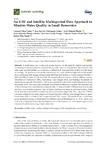An UAV and Satellite Multispectral Data Approach to Monitor Water Quality in Small Reservoirs

Ver/
Use este enlace para citar
http://hdl.handle.net/2183/25697
A non ser que se indique outra cousa, a licenza do ítem descríbese como Atribución 4.0 Internacional
Coleccións
Metadatos
Mostrar o rexistro completo do ítemTítulo
An UAV and Satellite Multispectral Data Approach to Monitor Water Quality in Small ReservoirsAutor(es)
Data
2020Cita bibliográfica
Cillero Castro, C.; Domínguez Gómez, J.A.; Delgado Martín, J.; Hinojo Sánchez, B.A.; Cereijo Arango, J.L.; Cheda Tuya, F.A.; Díaz-Varela, R. An UAV and Satellite Multispectral Data Approach to Monitor Water Quality in Small Reservoirs. Remote Sens. 2020, 12, 1514. https://doi.org/10.3390/rs12091514
Resumo
[Abstract] A multi-sensor and multi-scale monitoring tool for the spatially explicit and periodic monitoring of eutrophication in a small drinking water reservoir is presented. The tool was built with freely available satellite and in situ data combined with Unmanned Aerial Vehicle (UAV)-based technology. The goal is to evaluate the performance of a multi-platform approach for the trophic state monitoring with images obtained with MultiSpectral Sensors on board satellites Sentinel 2 (S2A and S2B), Landsat 8 (L8) and UAV. We assessed the performance of three different sensors (MultiSpectral Instrument (MSI), Operational Land Imager (OLI) and Rededge Micasense) for retrieving the pigment chlorophyll-a (chl-a), as a quantitative descriptor of phytoplankton biomass and trophic level. The study was conducted in a waterbody affected by cyanobacterial blooms, one of the most important eutrophication-derived risks for human health. Different empirical models and band indices were evaluated. Spectral band combinations using red and near-infrared (NIR) bands were the most suitable for retrieving chl-a concentration (especially 2 band algorithm (2BDA), the Surface Algal Bloom Index (SABI) and 3 band algorithm (3BDA)) even though blue and green bands were useful to classify UAV images into two chl-a ranges. The results show a moderately good agreement among the three sensors at different spatial resolutions (10 m., 30 m. and 8 cm.), indicating a high potential for the development of a multi-platform and multi-sensor approach for the eutrophication monitoring of small reservoirs.
Palabras chave
Satellite
Water quality
Multispectral imagery
UAV
Eutrophication
Monitoring
Water quality
Multispectral imagery
UAV
Eutrophication
Monitoring
Descrición
This article belongs to the Special Issue She Maps (https://www.mdpi.com/journal/remotesensing/special_issues/shemaps)
Versión do editor
Dereitos
Atribución 4.0 Internacional






